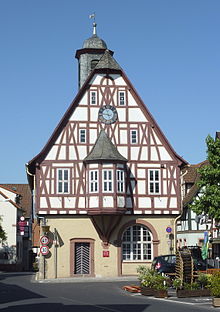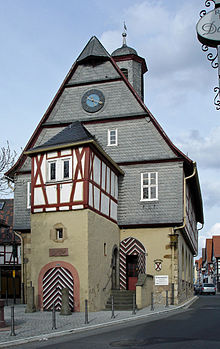Bergen-Enkheim town hall

The old Berger town hall as a public building and monument is considered to be one of the most beautiful preserved half-timbered houses of the rural late renaissance in the Frankfurt am Main area . Today it houses the Bergen-Enkheim local history museum and is a landmark of the formerly independent village of Bergen and later the Frankfurt district of Bergen-Enkheim . The building stands directly on Marktstrasse, the main thoroughfare of the district in the historic center of Bergen, and is surrounded by other half-timbered houses.
history

The town of Bergen was first mentioned on August 16, 1057 in a document from Henry IV . Bergen and Enkheim are mentioned as a local association as early as the 13th century. The so-called Spilhus ( playhouse ) and later town hall is therefore a common history of the districts of Bergen and Enkheim.
The present ground floor of the town hall was built from 1300 in the Gothic style as a Spilhus with an open hall and high roof and served Bergen and Enkheim around 1320 as a market and court square. It was built right on the then local border. The windows of today's rear front served as loopholes in the direction of Frankfurt am Main. After the construction of fortification walls, however, this function of the Spilhus ceased. The Untertor took over this task from then on.
Bergen had the right to stack or to lay down ( lat. Ius emporii , actually the market right in the sense of sales right). It included that traders passing through had to unload the goods they had brought with them for a certain period of time, which Berger citizens had to offer and sell. The open market hall in the Spilhus served this purpose.
On the stair tower on the rear facade there is a replica of a late Gothic head relief from 1479, a so-called grimace stone, the original of which is kept in the local museum.
In 1484, Bergen became a court of law. As a result, more space was needed for the court. It was decided to increase the Spilhus. The old high roof was removed beforehand. In 1507 a new roof structure was built.
The upper floors of the building were built between 1520 and 1530 in the late Renaissance style . A tower was added to the outside to the west to accommodate the stairwell. A two-leaf wooden gate with diagonal struts was provided for access.
The beams of the timber-framing of the Berger town hall were originally coated with a lye made from the serum of ox blood, lime, iron oxide ( hematite ) and linseed oil (example recipe), which gave them an intense red-brown color. This color was traditionally used by farmers for wooden floorboards and half-timbered beams and was cost-saving.
A staircase led to the first floor, which had a small porch facing the street. Its windows were used by the community servant to call out news and official announcements. However, he also announced this on his walk through the village after drawing attention to himself with a bell. The Great Hall, also located on the first floor, was probably reserved for council meetings and sessions of the Bergen Municipality Court.
A ridge turret with a lantern was added in 1704 in the Baroque style .
The back of the upper floors on the west side and the roof turrets are slated today. The Bergen-Enkheim local history museum has been housed in the town hall since 1959. Bergen-Enkheim received city rights on August 31, 1968. It was incorporated into Frankfurt am Main on January 1, 1977.
Roof renovation
Since the beginning of 2012, the museum has been closed to visitors from the first floor for extensive renovation and renovation of the roof structure and the floor. The exhibits and fixtures previously located there were relocated for this purpose.
Transport links
The old town hall or the museum of local history in Bergen-Enkheim can be reached by public transport using the RMV bus lines 42 and 43. The Heimatmuseum Bergen-Enkheim stop is in the immediate vicinity of the building. Parking spaces for motorized private transport can be found at the nearby town hall.
literature
- Henschke, Werner: Living Past in Bergen-Enkheim, The Magistrate of the City of Bergen-Enkheim (Ed.), 1976
- Emmel, Ludwig Fr .: Chronicle of a landscape on the Untermain Bergen-Enkheim, Bergen-Enkheim Home Foundation, 1985
- Heinemeyer, Karl-Heinz: Circular route through Bergen-Enkheim - A historical reflection, 1991
- Usener, Johann Heinrich: Cronick from the Bornheimerberg office started in 1796, edited by Walter Reul, Arbeitsgemeinschaft Heimatmuseum Ffm.-Bergen-Enkheim e. V., 1998
- Heinemeyer, Karl-Heinz: Bergen-Enkheim - A young district with an ancient history, Frankfurter Sparkasse (ed.), 2001
swell
- Institute for Urban History, Frankfurt am Main
- Society for Frankfurt History V.
- Bergen-Enkheim local history museum
- Matthias Arning: Home Frankfurt - Back in Bergen . Article of July 5, 2008 on the website of the daily newspaper Frankfurter Rundschau (accessed on June 21, 2014)
Web links
- State Office for the Preservation of Monuments Hesse (ed.): Old Town Hall / Local History Museum In: DenkXweb, online edition of cultural monuments in Hesse
- Bergen-Enkheim local history museum
- City of Frankfurt am Main, Altes Berger Rathaus, accessed on Feb. 22, 2020
- City of Frankfurt am Main, Bergen-Enkheim, accessed on Feb. 22, 2020
Individual evidence
- ↑ Taking care of the roof structure . Article in the Frankfurter Allgemeine Zeitung on February 16, 2012, page 42
- ↑ Tour of the local history museum on its website with photos of the construction work ( Memento from March 4, 2016 in the Internet Archive ) (accessed on June 21, 2014)
Coordinates: 50 ° 9 ′ 19.1 ″ N , 8 ° 45 ′ 13.9 ″ E
